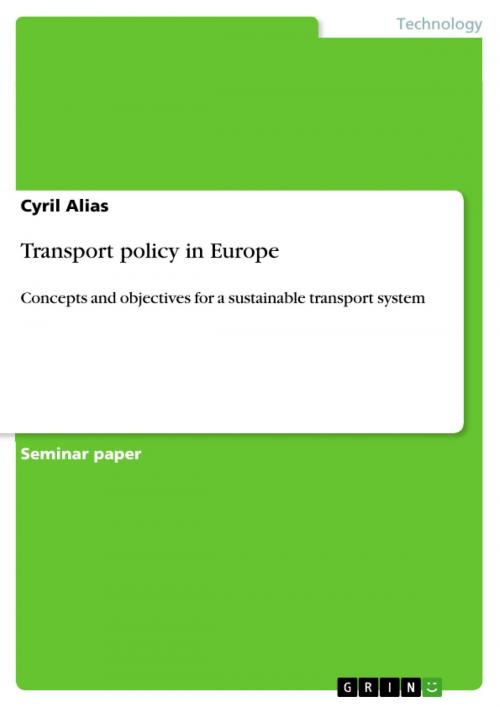Transport policy in Europe
Concepts and objectives for a sustainable transport system
Nonfiction, Science & Nature, Science, Earth Sciences, Geography| Author: | Cyril Alias | ISBN: | 9783638041454 |
| Publisher: | GRIN Publishing | Publication: | April 30, 2008 |
| Imprint: | GRIN Publishing | Language: | English |
| Author: | Cyril Alias |
| ISBN: | 9783638041454 |
| Publisher: | GRIN Publishing |
| Publication: | April 30, 2008 |
| Imprint: | GRIN Publishing |
| Language: | English |
Seminar paper from the year 2008 in the subject Transportation Science & Technology, grade: 1,3, University of Duisburg-Essen (Institut für Geographie (Wirtschaftsgeographie, insb. Verkehr und Logistik)), course: Verkehr und Nachhaltigkeit, 87 entries in the bibliography, language: English, abstract: All over the history, mobility has been an integral part of life. Europe features a high level of its unmatched infrastructure, allowing that mobility very well. Not only mobility of people, also the conveyance of goods profits from it. It has become a part of the European lifestyle since the citizens of the continent make use of transport services as a matter of course. Although the term 'Europe' is used, the essay mainly contains remarks about the transport sector of the European Union with its 27 member states by now. Transportation is termed as 'the totality of all translocations of persons [...] and goods [...] as well as news [...]' , 'which is to be geared to the needs for activity of men and to the environment.' The transport sector comprehends the extent of passenger use, the frequency of the lanes, the usage of the different means of transportation and the covered distances. As the title of this essay indicates, it is to deal with the concepts and objectives of a common transport policy throughout the European Union. The central and decisive element in this matter is the White Paper 'European transport policy for 2010 - Time to decide', published at the Gothenburg European Council in 2001. This document contains the essential abstract objectives and concrete measures or concepts for a more sustainable transport policy across the Union territory. These goals and measures can roughly be assigned to the two main categories of performance-enhancement and climate protection. By having referred to the 2006 Mid-term review during the presentation of current situation in the European transport sector, most interim results have already been presented earlier. Generally, it becomes obvious that progresses are made only sluggishly. In addition, the modal split balance is expected to remain stable. So, apart from certain exceptions, many premises do not change for the following action fields. After having considered the different sections of the transport policy in Europe, one can draw several conclusions. Sustained economic growth, which will continue to belong to the top priorities of the European Union, should be uncoupled from the rise in traffic volume. Therefore, efficiency and utilization rates have to be improved. At the same time though, environmental and social consequences of further growth has to be scanned carefully.
Seminar paper from the year 2008 in the subject Transportation Science & Technology, grade: 1,3, University of Duisburg-Essen (Institut für Geographie (Wirtschaftsgeographie, insb. Verkehr und Logistik)), course: Verkehr und Nachhaltigkeit, 87 entries in the bibliography, language: English, abstract: All over the history, mobility has been an integral part of life. Europe features a high level of its unmatched infrastructure, allowing that mobility very well. Not only mobility of people, also the conveyance of goods profits from it. It has become a part of the European lifestyle since the citizens of the continent make use of transport services as a matter of course. Although the term 'Europe' is used, the essay mainly contains remarks about the transport sector of the European Union with its 27 member states by now. Transportation is termed as 'the totality of all translocations of persons [...] and goods [...] as well as news [...]' , 'which is to be geared to the needs for activity of men and to the environment.' The transport sector comprehends the extent of passenger use, the frequency of the lanes, the usage of the different means of transportation and the covered distances. As the title of this essay indicates, it is to deal with the concepts and objectives of a common transport policy throughout the European Union. The central and decisive element in this matter is the White Paper 'European transport policy for 2010 - Time to decide', published at the Gothenburg European Council in 2001. This document contains the essential abstract objectives and concrete measures or concepts for a more sustainable transport policy across the Union territory. These goals and measures can roughly be assigned to the two main categories of performance-enhancement and climate protection. By having referred to the 2006 Mid-term review during the presentation of current situation in the European transport sector, most interim results have already been presented earlier. Generally, it becomes obvious that progresses are made only sluggishly. In addition, the modal split balance is expected to remain stable. So, apart from certain exceptions, many premises do not change for the following action fields. After having considered the different sections of the transport policy in Europe, one can draw several conclusions. Sustained economic growth, which will continue to belong to the top priorities of the European Union, should be uncoupled from the rise in traffic volume. Therefore, efficiency and utilization rates have to be improved. At the same time though, environmental and social consequences of further growth has to be scanned carefully.















